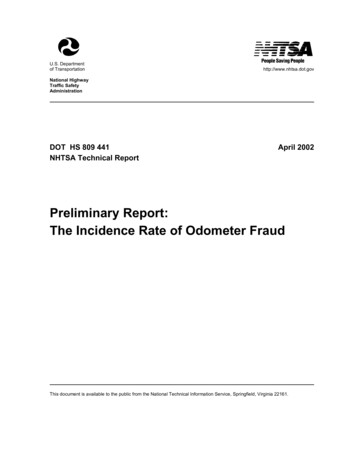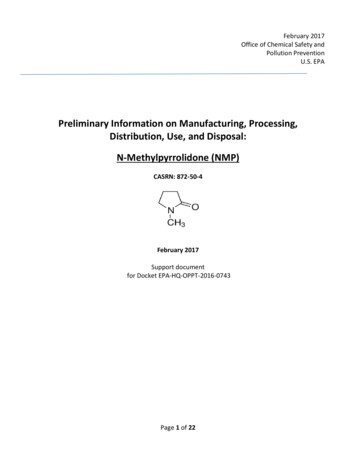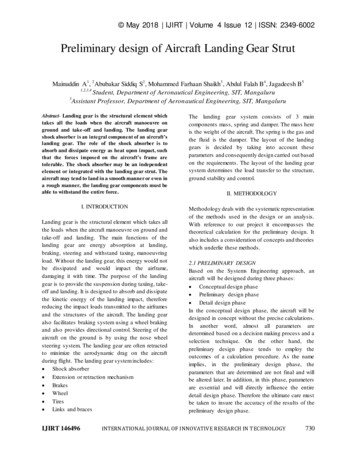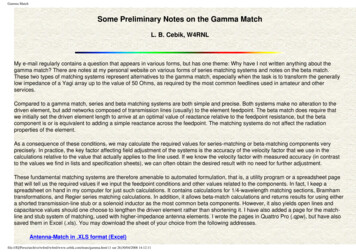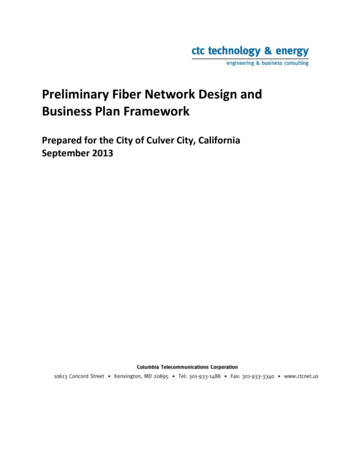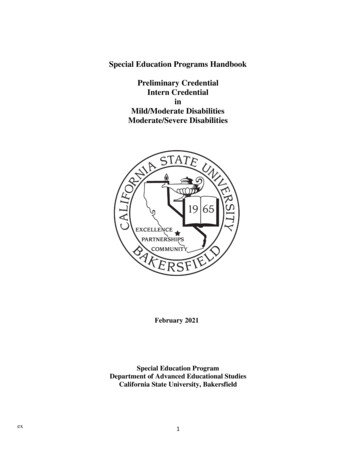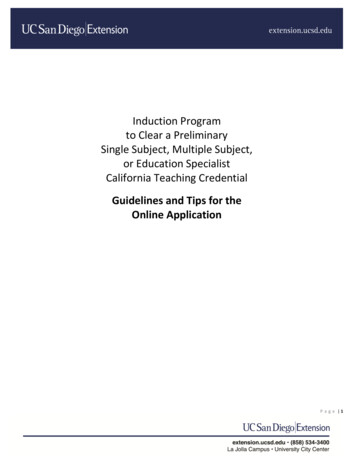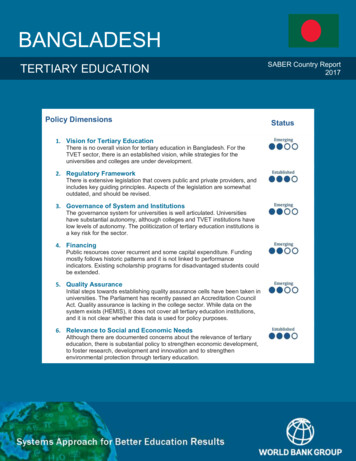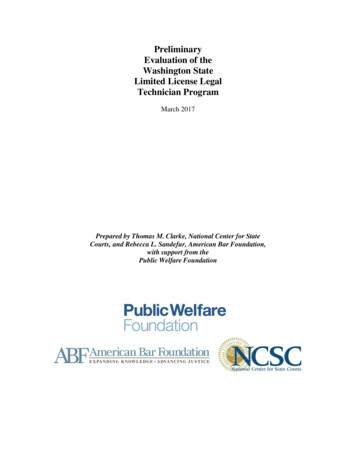
Transcription
PreliminaryEvaluation of theWashington StateLimited License LegalTechnician ProgramMarch 2017Prepared by Thomas M. Clarke, National Center for StateCourts, and Rebecca L. Sandefur, American Bar Foundation,with support from thePublic Welfare Foundation
Rebecca L. Sandefur and Thomas M. Clarke20172
Executive SummaryThe Washington State Supreme Court and the Washington State Bar Association created an innovativeprogram to expand the provision of legal services. Limited Licensed Legal Technicians (LLLTs)represent a new legal role that builds on the capabilities of traditional paralegals and operates withoutsupervision by lawyers. LLLTs primarily help customers fill out legal forms and understand legalprocedures. The program started with the family law practice area, but Washington State plans to expandto additional practice areas in the near future. A small number of LLLTs have been certified and arecurrently practicing.The evaluation shows that the program has been appropriately designed to provide legal services to thosewho cannot afford a lawyer but still wish or need assistance. The training program prepares LLLTs toperform their role competently while keeping within the legal scope of that role. Customers have foundtheir legal assistance to be valuable and well worth the cost. The legitimacy of the role appears to bewidely accepted in spite of its short track record.There are some questions about how best to scale up the program. The biggest current bottleneck is therequired year of training with the University of Washington (UW) Law School. Washington State isactively pursing other ways to mitigate that constraint. The regulatory costs of the program are not yetclose to breaking even, but scaling up the program significantly would resolve that issue. LLLTs wouldgreatly benefit from additional training on business management and marketing, but several of the firstLLLTs are successfully running a full-time LLLT practice.The example of the LLLT program in Washington State has already encouraged a second state to create asimilar program. Utah is currently designing its Paralegal Practitioner program along the lines of theWashington State program. Several of the recently approved program changes in Washington State wereincorporated immediately into the Utah program design.The LLLT program suggests that new legal roles with costs lower than traditional lawyers are apotentially significant strategy for meeting the legal needs of many people who now are dealing with theirlegal problems unassisted. Creating similar programs in other states would clearly improve access tojustice for a broad section of the public.3
Table of ContentsExecutive Summary . 3Research Summary and Reccommendations . 5Introduction. 5Evaluation Approach . 5Program Appropriateness . 6Program Efficacy . 8Program Sustainability . 9Conclusions . 14Recommendations . 14The Bottom Line . 15Appendix A. Acknowledgments . 164
Research Summary and RecommendationsIntroductionThe Washington Supreme Court’s Practice of Law Board started considering the possibility of creatingnew legal roles almost fifteen years ago. After many years of debate and discussion, the WashingtonSupreme Court adopted Admission and Practice Rule (APR) 28 authorizing the creation of the LimitedLicense Legal Technician (LLLT) role in June 2012. APR 28 created the Limited License LegalTechnician Board, which was tasked with developing and implementing the new license. The WashingtonState Bar Association (WSBA) staffs and funds the LLLT Board and regulates the LLLTs underdelegated authority from the Washington Supreme Court.After several years of work to create the regulations, training, and administrative mechanisms to do so,the first LLLT candidates entered their practice-area education classes in 2014. Three further classes havebegun the practice-area courses since then with many more students completing their core educationrequirements at the community college level. In 2015, the first LLLTs were licensed by the WashingtonSupreme Court. At the time research for this evaluation was conducted, there were fifteen (15) licensedLLLTs. Since then, that number has slowly continued to grow.1A number of other states have expressed interest in the possibility of starting similar programs. Given thatinterest, the Public Welfare Foundation (PWF) decided to fund an independent academic evaluation of theLLLT program. Because of its more general interest in new legal roles, the PWF also funded anevaluation of the New York City Navigator program by the same research team.Evaluation ApproachSince it was likely that states would create both similar new roles and other kinds of new legal roles, theresearch team first created an evaluation framework that was flexible enough to encompass a broad rangeof possible new legal roles.2 The framework was also intended to support a variety of performance andevaluation measures. Given different program objectives, a particular program evaluation might utilizeonly a subset of the available evaluation dimensions, but at least the approach would be roughlyconsistent across program types and evaluator teams.The framework identifies three broad evaluation categories at the highest level: appropriateness, efficacy,and sustainability. Essentially, researchers want to know if a program does the right thing, does iteffectively, and is capable of doing it into the future. To know if the program is doing the right thing, it isnecessary to see if the tasks performed by the new role align with the problems that are to be solved or thedesired new services. It is also necessary to determine if the persons in the new role will be trained toperform those tasks.1For an excellent summary of the history, scope, and current status of the LLLT program, see “Report of theLimited License Legal Technician Program to the Washington Supreme Court: the first three years,” February 2016,Washington State Bar Association.2INCREASING ACCESS TO JUSTICE THROUGH EXPANDED ‘ROLES BEYOND LAWYERS’:PRELIMINARY EVALUATION AND CLASSIFICATION FRAMEWORKS, Rebecca L. Sandefur and ThomasM. Clarke, American Bar Foundation and National Center for State Courts, Chicago, IL and Williamsburg, VA,March 2015.5
To be effective, researchers must see if the identified tasks are being performed competently by those inthe new role and that, when they do so, the impacts on the targeted problems are positive and beneficial.Finally, the sustainability of the program requires positive answers to three different kinds of questions.Does the regulatory regime, including training, have a stable basis? Does the business model for the newrole have a stable basis? Do customers, clients, and colleagues of the new role attribute to it enoughlegitimacy to provide a stable clientele?At the time of this evaluation the LLLT program was about 15 months old. The small number of certifiedLLLTs did not permit a rigorous statistical evaluation. As a result, the researchers opted for a moreethnographic approach using structured interviews. Thus, this evaluation must be considered preliminaryand provides first impressions of how the program is progressing. More definitive results must await alarger number of certified LLLTs.The researchers interviewed 13 of the 15 then certified LLLTs, mostly by telephone.3 They alsointerviewed four clients, several colleagues of various types, and representatives of both the regulatoryoffice at the WSBA and the training schools at several state community colleges and the UW School ofLaw.Program AppropriatenessThe stated objective of the LLLT program is to increase access to justice for low and moderate-incomepersons while protecting the public by ensuring the provision of quality legal services. This broadobjective could not be pursued all at once. Instead the LLLT Board and the WSBA envisioned a moreincremental approach to the new role. APR 28 was designed to have LLLTs licensed in specific practiceareas, with the number of practice areas approved by the Supreme Court to grow over time. ProspectiveLLLTs would meet the qualifications and become licensed in each practice area separately. As practiceareas were added, already licensed LLLTs could decide in which of any additional practice areas theywanted to become licensed.The scope of the LLLT’s authority was limited to be consistent with the training and testing requisite of alimited license. For example, LLLTs were barred from representing clients in talks or negotiations withlawyers or other parties. They also could not go into court hearings with their clients and assist themthere. These restrictions still enabled LLLTs to provide process assistance and forms assistance. In thefirst practice area of family law, LLLTs can assist in these ways on a wide range of family law matters.Training on these tasks followed a three-pronged approach. First, candidates had to receive, at aminimum, an associate level degree with 45 of the credits defined in the LLLT regulations. The courseswere to be completed in an ABA-approved paralegal program. Upon the completion of this “coreeducation,” candidates then complete 15 credits in family law through a curriculum developed by anABA-approved law school. Currently, the courses are offered through the UW School of Law, withGonzaga University law professors helping to teach the courses. Concurrent with the education,candidates spend 3,000 hours working under the supervision of a licensed lawyer. In addition to theserequirements, candidates must pass three exams: one at the completion of the core education (the3The researchers interviewed LLLTs, WSBA staff, lawyers, clients, and educators.6
Paralegal Core Competency (PCC) Exam), an exam on the LLLT Rules of Professional Conduct, and asubject area exam.4In order to facilitate a faster “ramp up” of the new program, the Court approved a waiver path to thelicense recommended by the LLLT Board. The waiver is allowed for existing paralegals who have spentat least ten years performing substantive legal work under the supervision of an attorney and have currentnational certification with one of the national paralegal association. If these requirements are met, theLLLT candidate can proceed directly to the practice-area education and the requisite exams required forlicensure. This waiver was initially put in place until the end of 2016, but the LLLT Board wasconsidering an extension as this study was being done. In fact, most of the current LLLTs satisfied theircore education requirement in this way, while a few of the newest LLLTs went through the completeeducation cycle.Discussion:Although most of the waivered LLLTs gained most of their experience in family law, the experiencerequirement does not require practice in family law matters. This suggests that the experience requirementis intended to provide general familiarity with legal procedures and processes, rather than specificexpertise in family law. This means that the formal training curriculum must provide all required contentfor the family law practice area.Not all of the community colleges in Washington State that provide paralegal programs are ABAapproved. That means that certain areas of the state are not conveniently served for that portion of thetraining requirements. The Supreme Court subsequently approved teaching the core courses at all LLLTBoard approved community colleges, mitigating the problem of geographical access significantly. Incontrast to the community college approach, the law school year of training is done entirely online,making it easy for candidates from all areas of the state to participate.The law school had no precedent for this kind of training, so essentially it had to create both a newbusiness process and a new business model for the LLLT program. The new process is able to takeadvantage of some of the services offered to regular law students, but not others. In particular, prospectiveLLLTs cannot avail themselves of any financial aid opportunities at the law school.The UW School of Law originally expected much larger numbers of prospective LLLTs to matriculate.The much smaller initial numbers of students enabled the University of Washington law school to moreeasily revise its original approach as it learned what worked best. The annual cohorts of students will stillneed to increase significantly if the university is to achieve a breakeven point on the economics of theprogram and provide appropriate management. Estimates of the desired cohort size were rough andranged from 25 to 100 students. It is also not clear if the law school can provide enough faculty to supportstudent cohorts of this size. In short, the economics of the law school training business model are stillsomewhat uncertain.Representatives of the community colleges with non-ABA-approved paralegal programs expressed astrong interest in becoming approved LLLT training programs. More broadly, representatives of the4The 2016 WSBA report describes these education requirements as: “At a minimum possess an associate leveldegree; complete 45 credits of core curriculum in paralegal studies as defined in the regulations; complete 15 creditsof practice area course work; have 3,000 hours of work experience under the supervision of a licensed Washingtonattorney; pass a rigorous core curriculum examination; pass a rigorous practice area examination; and pass arigorous professional responsibility examination.”7
community colleges expressed a strong interest in the possibility of teaching the entire trainingcurriculum, including the year that is now taught at the law school.Findings: The law school must subsidize the LLLT program at current student levels.It is not clear how much the student levels would need to increase for the law school to breakeven on the program. Rough estimates ranged from 30 to 60 students per year. Upcomingcohorts from the community colleges may be growing already, but if so it will not be visibleyet.It is not clear to what extent staffing and other bottlenecks at the law school would constrainstudent numbers if they increased significantly.Participating community colleges are currently unable to reliably identify which of theirparalegal students intend to become LLLTs.Teaching the practice area classes at community colleges using remote law professors,community college professors, or adjunct faculty would be one way to mitigate the possiblebottleneck at the law school.The Seattle University and Gonzaga University law schools are struggling financially and feltunable to subsidize a new program like the LLLTs. Gonzaga University has contributedfaculty to the courses at the UW School of Law.The inability of the UW School of Law to provide any kind of financial aid is a significanteconomic deterrent to prospective students.Allowing non-ABA-approved paralegal programs to qualify as part of the LLLT trainingprogram would significantly improve geographical convenience for students. [Arecommendation to make this change has been subsequently proposed and approved by theWashington State Supreme Court.]Program EfficacyThe LLLT program is designed to provide assistance with the legal process and the preparation of legalforms. Program designers believe that consumers find these kinds of processes to be significant barriersto access when they cannot afford the assistance of a full-service lawyer. Thus, it was hoped that LLLTswould competently provide such services at a significantly lower cost to consumers and by doing soconstitute an effective solution to this access problem.If LLLTs are to benefit consumers in this way, it must be true that they can competently help with thesekinds of tasks. It must also be true that consumers trust LLLTs to perform these tasks for them. Finally,competent assistance should result in better legal outcomes and may also improve perceived proceduraljustice.Discussion:Licensed LLLTs with education waivers uniformly felt competent to provide appropriate assistance infamily law matters according to the defined scope of the role. This opinion was partly supported byLLLTs without family law experience, who did not feel they could provide assistance efficiently enoughto charge their desired prices until they had more experience. It will be interesting to see how theseopinions and perceptions change as more LLLTs go through the program without the long years of priorfamily experience as paralegals.8
Clients were sometimes confused about exactly what LLLTs could and could not do. Because the linebetween allowable and forbidden types of assistance followed the complexity of legal tasks and not thetypical tasks in types of family law actions, clients were sometimes forced to do things by themselves thatthey wanted LLLTs to do or were required to contract with lawyers for unbundled assistance when it wasavailable. These distinctions made no sense to them as lay persons.From a process viewpoint, LLLTs walked clients through the engagement agreement and explained theirscope in detail. Some LLLTs made referrals to lawyers when they were unable to perform a task that aclient needed. Conversely, some lawyers made referrals to LLLTs when tasks were within their scope andclients could not afford a lawyer.Findings: Family law task competence was strongly ascribed to specific family law experience as aparalegal.At the same time, the training curriculum was deemed appropriate and adequate for thefamily law practice area.LLLTs suggested that the current training program be expanded to include a greater emphasison practical completion of forms.LLLTs thought the 3,000 hours of experience required was about right.LLLTs also suggested that a subset of the experience hours should be dedicated to family lawmatters. Proposed ranges of dedicated experience hours ranged 500 to 1,000 hours out of atotal of 3,000 hours.Some, but not all, of the small group of licensed LLLTs that went through the entire trainingsequence felt that they lacked enough specific family law experience to be fully competent atthe beginning of their practice.Clients uniformly reported that LLLTs provided competent assistance.Clients reported that their legal outcomes were improved by utilizing the services of LLLTs.Clients were unable to articulate in what way procedural justice was improved for them, butthey did frequently report reductions in stress, fear, and confusion.Some clients expressed a desire for LLLTs to provide similar assistance for excluded familylaw matters.Some clients expressed a desire for LLLTs to be able to represent them in conversations ornegotiations with opposing lawyers and parties.Some clients expressed a desire for LLLTs to accompany them into court and at least assistthem in answering questions during court hearings.Clients often
similar program. Utah is currently designing its Paralegal Practitioner program along the lines of the Washington State program. Several of the recently approved program changes in Washington State were incorporated immediately into the Utah program design. The LLLT program suggests that new



